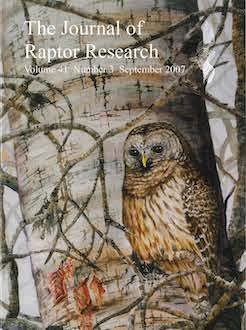Barred Owls (Strix varia) historically inhabited the forests of eastern North America. During the last century, they expanded their range to include forests throughout the southern provinces of Canada, southeastern Alaska, British Columbia, Washington, Oregon, and northern California. To date, there has been no synthesis of the varied habitats or prey used by Barred Owls in their expanded range. Here I review and synthesize studies concerning habitat (N = 114) and prey (N = 43) of Barred Owls throughout North America north of Mexico. Barred Owls nested in wilderness areas and national parks as well as small suburban woodlots. They typically preferred old or mature, mixed deciduous/coniferous forests with fairly high canopy closure. Barred Owl nests in natural locations (N = 341) were in cavities (74.8%), hawk nests (12.9%), tops of hollow trees (8.2%), squirrel nests (2.1%) and other locations (2.1%). Trees used by Barred Owls for nesting (N = 169) included 22 genera, although one-fourth of all reported nest trees were Populus. Barred Owls used significantly more coniferous nest trees than deciduous nest trees in their expanded range vs. their historic range. They also nested in nest-boxes (N = 103), in buildings (N = 6), on nesting platforms (N = 2), on the ground (N = 2), in a creek bank (N = 1), and under a bridge (N = 1). Prey individuals (N = 7077) obtained from pellets (N = 5504) were mammals (74.7%), birds (8.3%), amphibians (6.4%), insects and spiders (5.6%), crayfish (3.0%), fish (1.5%), reptiles, snails and slugs, and earthworms (<1.0% each). The distribution of prey types documented by other means (e.g., observations, prey remains; N = 1573) was significantly different, due especially to more earthworms in non-pellet samples: mammals (62.0%), birds (13.5%), insects and spiders (9.5%), amphibians (4.8%), earthworms (4.5%), fish (3.3%), reptiles (1.1%), snails, and crayfish (<1.0% each). The distributions of prey types in all samples that could be placed into winter or non-winter months (N = 4631) differed seasonally, with more mammals in the winter diet (98.4%, vs. 58.9% in non-winter months) and more birds (11.9%), insects or spiders (11.4%), amphibians (10.7%), earthworms (2.3%), fish (2.0%), and crayfish (2.0%) in non-winter months.
How to translate text using browser tools
1 September 2007
BARRED OWL HABITAT AND PREY: A REVIEW AND SYNTHESIS OF THE LITERATURE
Kent B. Livezey

Journal of Raptor Research
Vol. 41 • No. 3
September 2007
Vol. 41 • No. 3
September 2007
Barred Owl
habitat
prey
Strix varia




